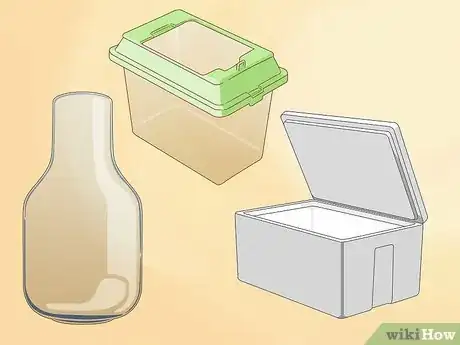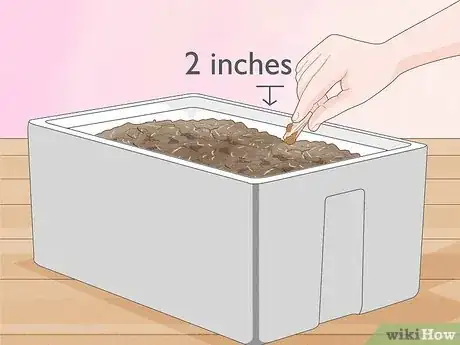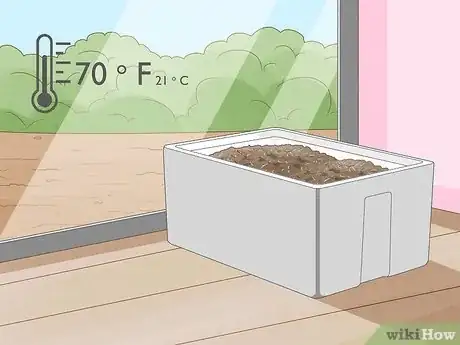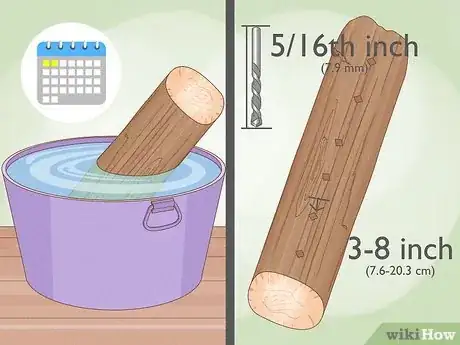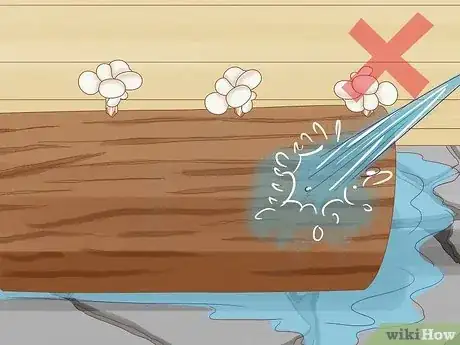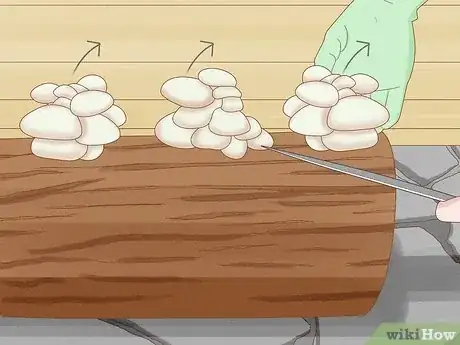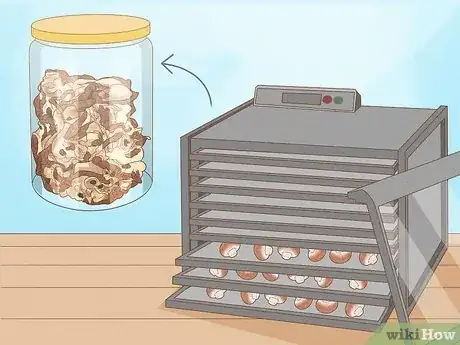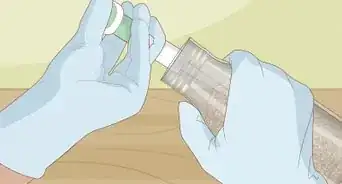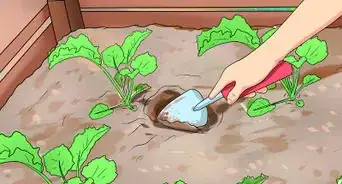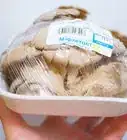This article was co-authored by Andrew Carberry, MPH. Andrew Carberry is a Food Systems Expert and the Senior Program Associate at the Wallace Centere at Winrock International in Little Rock, Arkansas. He has worked in food systems since 2008 and has experience working on farm-to-school projects, food safety programs, and working with local and state coalitions in Arkansas. He is a graduate of the College of William and Mary and holds a Masters degree in public health and nutrition from the University of Tennessee.
There are 7 references cited in this article, which can be found at the bottom of the page.
This article has been viewed 196,765 times.
Mushrooms are delicious, but the gourmet varieties can be expensive and difficult to find fresh. If you're a big fan of cooking with mushrooms, you can keep your kitchen stocked and your kitchen diverse by growing your own unique varieties, ensuring that you've always got a fresh fungus to cook with. This article will explain how to select varieties, methods of fruiting, and cooking techniques for your mushrooms.
Steps
Growing and Harvesting Mushrooms
Terrarium Method
-
1Choose a cooler or terrarium with a lid. Styrofoam coolers, plastic terrariums, or even old grow-trays covered with enough wet newspaper can be used to grow mushrooms in the right environment.
- If you've got a dark basement in which to grow your mushrooms, you don't necessarily need a growing chamber with a lid. Use or build some 6-inch deep trays to grow your mushrooms in.
- Use an old fishtank or a plastic storage bin for growing mushrooms in drier climates, or if you don't have a basement in which to grow your mushrooms and need to regulate the temperature more readily.
-
2Fill your container with medium that is suitable for mushroom growing. You can buy your own pre-mixed beds to grow mushrooms, or make your own. Materials as diverse as manure, rye meal, vermiculite, and sawdust are used successfully for growing different varieties of edible mushrooms, but the basic mix will need to include compost and wood chips.
- The medium is very important, because mushrooms--unlike plants--can't manufacture their own nutrients and need an appropriate mix of sugars, starches, cellulose, and nitrogen. The kind of substrate you'll want to create for growing your mushrooms depends on the variety you want to grow:
- A manure-based compost is most appropriate for button varieties. Straw-rich horse manure, aged to the proper pH is appropriate. Many large-scale growers find it easier to make compost from corn fodder, straw, peat moss, tankage, and greensand instead.[4]
- To prepare a fruiting substrate for morel spawn, mix together 80% small hardwood chips, 10% rice hulls, 5% soybean meal, and 5% sphagnum, then add a little lime to adjust the pH to 7.1 to 7.3. Next, combine 5 parts of this mixture with 2 parts sand and 3 parts potting soil and mix well.[5]
-
3"Plant" the mushroom spawn. Plant your spawn about two inches deep in your substrate, several inches spaced from your other plantings.
- Alternatively, you can sprinkle your growing chamber with your spawn and cover with compost.
-
4Keep the chamber at 70 degrees Fahrenheit, or 21 degrees Celsius. Placing the container in a heated room or in direct sunlight may be used to regulate the heat. It will take about 3 weeks for the roots to spread into the medium.
- You want to check for the thin, white thread-like mycelium, which serve as the root base of the mushrooms. When you see this spiderweb-like formation happening, place the container in a darkened room or basement, so that the temperature is reduce to 60 degrees Fahrenheit or 16 degrees Celsius, and cover the spawn with a 1 inch (2.5 cm) layer of regular potting soil.
-
5Spray the soil surface with water to keep it slightly damp. Do this regularly. A wet cloth is also useful for keeping the mushroom and soil damp. If you are keeping the container in a heated indoor space, then spraying everyday is necessary.
-
6Maintain cloth and soil dampness and temperature for 3 to 4 weeks. During this time, keep an eye out for any problems. You may need to start over if you notice pin-prick dots of black fungus, or if your substrates is over-saturated and slimy. Remove the cloth that your mushroom spawn came in once mushrooms begin to poke out of the soil.
-
7Harvest the mushrooms. The mushrooms are ready to be picked when the "veil" connecting the cap to the step of the mushroom is lifted. As soon as you see this happen, the mushrooms are at their optimum ripeness and deliciousness. Pick them.
- Don't pull them up from the substrate and risk knocking loose other mushrooms. Hold them firmly and twist them out, or use a small knife to cut them off near the base.
- Picking the mushrooms regularly is important--don't wait. Keeping the ripe mushrooms out of the way allows the flush to continue spreading, leading to a fruitful harvest.
Log Method
-
1Start with hardwood logs and plug spawn. You can buy pre-inoculated logs directly from spawn suppliers, or start with ordinary fresh-cut logs with the bark intact. Oak is ideal, but you can also use other hardwood such as hard maple, hornbeam, ironwood, or sweet gum.[6] Regardless of your choice, the logs should be about 4 feet (1.2 m) long and 4 to 8 inches (10 to 20 cm) in diameter. If you use your own logs, you'll also need "plug spawn," or cylinders of mushroom spawn specifically for growing in logs. Oyster mushrooms and shiitake are two varieties commonly sold as plug spawn.
- For best results, cut the logs in late winter or spring. The wood is richer in sugars at this time, so the mushrooms have more to feed on.[7]
-
2Inoculate the logs. If you are starting with your own logs, inoculate them within three weeks of cutting to stop the growth of undesirable organisms:
- If the wood is unusually dry due to a drought or a long storage period after felling (more than one or two months), soak the logs in clean water for a day or two, then let dry completely.[8]
- Gently clean off all moss, lichens, and other organisms that could compete with your mushrooms.
- Drill a diamond-shaped pattern of 3–8 inch (7.6–20.3 cm) holes in each log. Use a 5/16th inch (7.9 mm) drill bit and make each hole deep enough to insert the plug spawn.
-
3Insert plug spawn with a wax cover. Tap the plug spawn fully into each hole with a hammer, or use the inoculating tool included in some types of plug spawn kits. Knock off any protruding excess spawn, then cover the holes with a thin layer of beeswax or cheese wax to protect the spawn from pests. The wax should be heated just hot enough to melt, but no hotter, to avoid starting a fire.[9]
-
4Keep the logs in shade. Avoid wind and sun. You can purchase fruiting blankets to cover the logs with, or find a location with about 60% shade-cover to allow your logs time to fruit. A location near a building or evergreen trees is ideal, since they provide shade year round.
-
5Keep the logs moist until mushrooms form. It's important to keep the logs about 50% saturated with water so the spawn can establish itself.[10] For best results, set up a misting system or sprinkler for light misting over a long period of time. You can instead spray heavily with a hose (or rain) for two to three hours twice a week instead, but this may be less reliable.
-
6Stop spraying when the mushrooms fruit. Once you see white mycelium reach the ends of the log, start checking regularly for fruiting (the formation of tiny mushroom "pins" that will grow to full size). Stop watering once this happens unless you experience very hot, dry weather. Fruiting takes anywhere from five to twelve months for shiitake mushrooms. Oyster mushrooms may be ready in much less time, but all mushrooms require at least one warm season before fruiting.[11]
- If you let the fruiting happen naturally, most or all of your mushrooms will be ready in spring and fall. Commercial growers often practice "forced fruiting" in summer and winter, soaking the logs and controlling temperature and humidity for year-round production.[12] Forced fruiting is more difficult and labor-intensive.
-
7Harvest the mushrooms. When you see the veil of the mushroom lift away from the stem, it's time to harvest your oysters and your shiitakes. Twist them off or cut them with a knife.[13] You can let the mushrooms grow larger before harvesting, but this will reduce the overall number of harvested mushrooms per log.[14]
-
8Start a new harvest in six to eight weeks. After this rest period, your logs will be ready for new spawn.
Cooking Your Mushrooms
-
1Prepare your mushrooms to eat by brushing them of dirt. You don't need to soak the mushrooms or wash them considerably to get them ready to cook. Use a paper towel to brush any dirt or stray particulate from the mushrooms and trim off the stem ends. Discard the stems of shiitakes completely, or save them for making stocks or stews.
- Some people disagree on the proper method of cleaning mushrooms. You can get them wet, and getting them wet won't ruin the mushrooms, especially if you're eating them right away, but you don't need to. Make sure there's no large dirty spots on them, and they're fine to eat.
-
2Make marinated mushrooms. One of the most simple and delicious ways to prepare and eat your fresh mushrooms is by cooking them quickly in butter and oil and letting them chill overnight to gain flavor. For this recipe, you'll need:
- A pound of fresh mushrooms, any variety, chopped into quarters or halves
- a tablespoon of butter
- three tablespoons of olive oil
- half an onion, chopped (or shallots, if you prefer)
- two cloves of garlic, chopped
- half cup of dry red wine
- a handful of chopped green herbs, like oregano, thyme, or parsley
- salt and pepper to taste
- Heat the butter and a tiny amount of olive oil in a pan on medium-high heat until the butter bubbles. Add the onion and garlic and cook until translucent.
- Add the mushrooms. Do not stir for a minute or two until you hear them start to sizzle. That means the water is being released. Sprinkle them with salt and pepper and toss them to coat them with the garlic and onions. Continue browning the mushrooms.
- Add more oil as the liquid cooks off and deglaze the pan with the red wine. Let some of the liquid cook off and add the chopped herbs and seasoning to taste. You can eat it now for a delicious side dish or transfer it to a container to chill overnight.
-
3Make a mushroom omelette. Mushrooms and eggs go together well, combining a meaty and substantial substitute to pork. It's perfectly simple and complex at the same time.
-
4Experiment with your mushrooms. Cooking mushrooms are versatile and delicious any way you prepare them. Use your imagination and try different combinations. You can make:
- Mushroom risotto
- Mushroom pizza
- Mushroom soup
- Mushroom stroganoff
- Stuffed mushrooms
-
5Consider drying your mushrooms. If you end up with several pounds of fresh mushrooms, it may be difficult to use them all at once. Consider investing in a food dehydrator to keep your kitchen well stocked with your own produce well into the year.
Community Q&A
-
QuestionHow do I grow shiitake mushroom indoors using straw or sawdust?
 NinoxTop AnswererShiitake must be planted in the winter or early spring. You need to plant at least 2 tray area cases of spores. Keep the tray away from the sun and the wind, but ensure that it stay humid. The mushrooms will appear within 10 days.
NinoxTop AnswererShiitake must be planted in the winter or early spring. You need to plant at least 2 tray area cases of spores. Keep the tray away from the sun and the wind, but ensure that it stay humid. The mushrooms will appear within 10 days. -
QuestionCan I grow chanterelle mushrooms?
 Community AnswerNo, chanterelle don't grow easily indoors.
Community AnswerNo, chanterelle don't grow easily indoors.
Warnings
- Do not use mushrooms that are white underneath! These are poisonous!⧼thumbs_response⧽
- when using wood chips as a medium, check to make sure that the mushroom can tolerate this type of wood.⧼thumbs_response⧽
- It will be more difficult to grow mushrooms outside from the start.⧼thumbs_response⧽
References
- ↑ http://www.garden.org/ediblelandscaping/?page=201111-edible
- ↑ http://www.oystercreekmushroom.com/shiitakekit.html
- ↑ http://www.wildmanstevebrill.com/mushrooms.html
- ↑ http://hnr.k-state.edu/doc/hort-tips/Growing%20Mushrooms.pdf
- ↑ http://www.gorsky.com/~pdilley/Grow_Morel_Mushrooms/Online_instructions.html
- ↑ https://www.mushroompeople.com/how-to-cultivate-mushrooms-in-natural-logs/
- ↑ http://www.motherearthnews.com/organic-gardening/grow-your-own-mushrooms-zmaz04onzsel?pageid=3#PageContent3
- ↑ https://www.mushroompeople.com/how-to-cultivate-mushrooms-in-natural-logs/
- ↑ https://www.mushroompeople.com/how-to-cultivate-mushrooms-in-natural-logs/
- ↑ http://www.motherearthnews.com/organic-gardening/grow-your-own-mushrooms-zmaz04onzsel?pageid=3#PageContent3
- ↑ https://www.mushroompeople.com/how-to-cultivate-mushrooms-in-natural-logs/
- ↑ https://www.mushroompeople.com/how-to-cultivate-mushrooms-in-natural-logs/
- ↑ http://www.oystercreekmushroom.com/shiitakekit.html
- ↑ https://www.mushroompeople.com/how-to-cultivate-mushrooms-in-natural-logs/
About This Article
To grow edible mushrooms, start by purchasing mushroom spawns in an easy-to-grow variety, such as crimini or shiitakes. Then, fill a styrofoam cooler or a terrarium with a substrate suitable for growing mushrooms, like rye meal or saw dust, and leave them in a dark, warm room for 3 weeks. When the roots begin to grow, cover them with 1 inch of potting soil and keep the soil surface slightly damp for another 4 weeks. Once the veil connecting the cap to the stem is lifted, harvest the mushrooms by cutting the base with a sharp knife. For tips from our Gardening reviewer on how to grow mushrooms on a log, read on!

